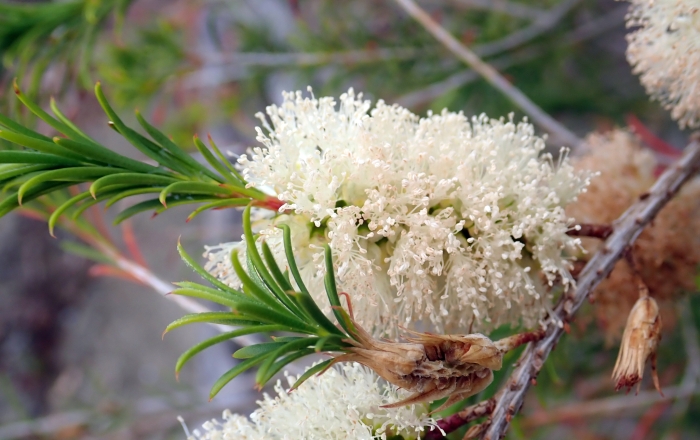Bracelet Honey Myrtle
(Melaleuca armillaris)
Bracelet Honey Myrtle (Melaleuca armillaris)
/
/

Peter de Lange
Public Domain
Image By:
Peter de Lange
Recorded By:
Copyright:
Public Domain
Copyright Notice:
Photo by: Peter de Lange | License Type: Public Domain | License URL: http://creativecommons.org/publicdomain/zero/1.0/ | Rights Holder: Peter de Lange | Publisher: iNaturalist | Date Created: 2019-12-01T09:31:34-08:00 |















































Estimated Native Range
Summary
Melaleuca armillaris, commonly known as Bracelet Honey Myrtle, is an evergreen shrub or small tree native to coastal regions, heathlands, and open forests of Southern Australia. It typically grows to a height of 8 m (30 ft) and has a weeping habit with distinctive decumbent branching and dense foliage. The bark is rough and grey, fibrous in texture, contributing to the plant’s visual interest. Bracelet Honey Myrtle produces white to cream-colored flowers, and on rare occasions, pink. These flowers are showy, arranged in cylindrical spikes along the branches, often on older wood, and bloom predominantly from spring to early summer. The fruit consists of woody capsules, which persist on the plant, adding to its ornamental value.
Bracelet Honey Myrtle is valued for its rapid growth and dense foliage, making it an excellent choice for windbreaks or privacy screens in cultivation. It thrives in a range of soil types, provided they are well-drained, and it can tolerate both full sun and part shade. While it is drought-tolerant once established, regular watering will promote more vigorous growth. This species is also used for erosion control due to its robust root system. However, gardeners should be aware that Melaleuca armillaris can become invasive outside its native range, so it is essential to check local regulations before planting. It is also susceptible to webbing caterpillars that can defoliate the plant if not controlled.CC BY-SA 4.0
Bracelet Honey Myrtle is valued for its rapid growth and dense foliage, making it an excellent choice for windbreaks or privacy screens in cultivation. It thrives in a range of soil types, provided they are well-drained, and it can tolerate both full sun and part shade. While it is drought-tolerant once established, regular watering will promote more vigorous growth. This species is also used for erosion control due to its robust root system. However, gardeners should be aware that Melaleuca armillaris can become invasive outside its native range, so it is essential to check local regulations before planting. It is also susceptible to webbing caterpillars that can defoliate the plant if not controlled.CC BY-SA 4.0
Plant Description
- Plant Type: Shrub, Tree
- Height: 5-7.5 feet
- Width: 7-10 feet
- Growth Rate: Rapid
- Flower Color: White
- Flowering Season: Spring, Summer
- Leaf Retention: Evergreen
Growth Requirements
- Sun: Full Sun, Part Shade
- Water: Low
- Drainage: Slow, Medium, Fast
Common Uses
Bee Garden, Bird Garden, Butterfly Garden, Hedges, Hummingbird Garden, Low Maintenance, Salt Tolerant, Showy Flowers, Street Planting
Natural Habitat
native to coastal regions, heathlands, and open forests of Southern Australia
Other Names
Common Names: Swamp Paperbark, Giant Honey Myrtle
Scientific Names: , Melaleuca armillaris,
GBIF Accepted Name: Melaleuca armillaris (Gaertn.) Sm.